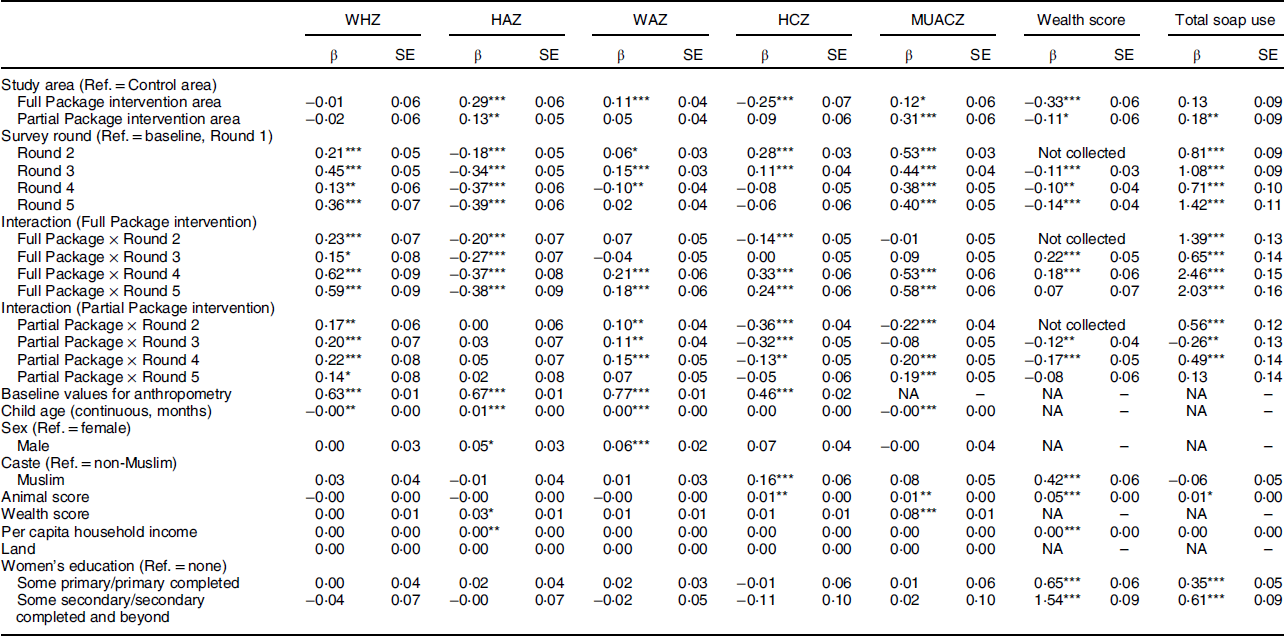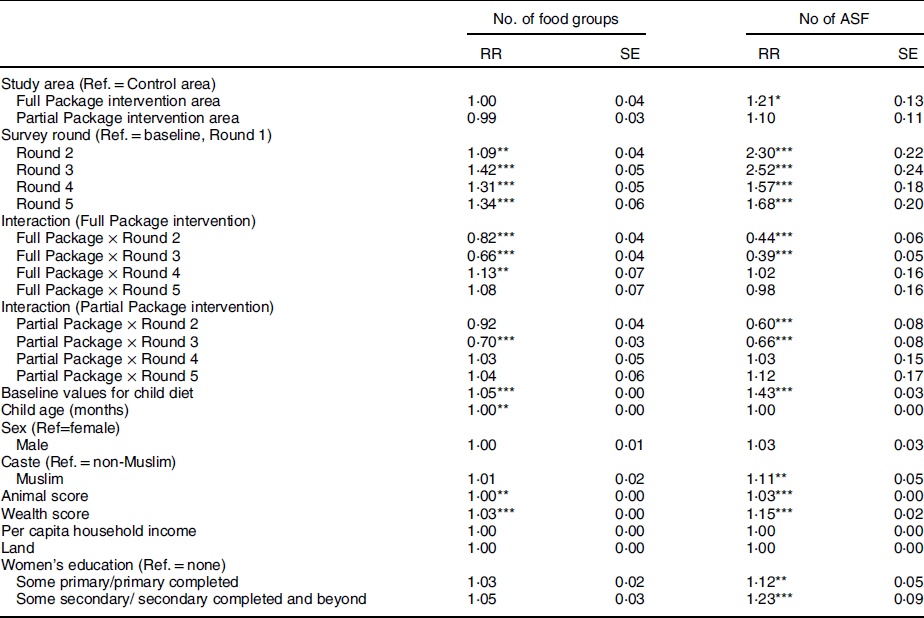Original text and correction:
In Tables 3 and 4, the authors incorrectly included the z statistic in the columns marked ‘SE’; this is corrected below.
ORIGINAL TEXT (page 9, Results)
Table 3 Mixed-effect linear regression showing coefficient (β) and SE for anthropometric measurements, household wealth score and total soap use (hygiene measure). Results are shown by survey round, treatment group and group-by-round interaction as a fixed effect adjusted for child factors (age, gender, baseline anthropometry) and household factors (household animal and wealth score, land ownership, household per capita income, mother’s educational attainment)

WHZ, weight-for-height Z-score; HAZ, height-for-age Z-score; WAZ, weight-for-age Z-score; HCZ, head circumference Z-score; MUACZ, mid-upper arm circumference Z-score; Ref., reference category; NA, not applicable. Households with children aged 1–60 months from Banke, western Nepal, were randomized to receive: (i) multisectoral community development activities (Full Package), (ii) nutrition education and livestock management training alone (Partial Package) or (iii) no intervention (Control); the study was conducted between August 2013 and August 2017.
*P < 0·10, **P < 0·05, ***P < 0·01.
CORRECTION
Table 3 Mixed-effect linear regression showing coefficient (β) and SE for anthropometric measurements, household wealth score and total soap use (hygiene measure). Results are shown by survey round, treatment group and group-by-round interaction as a fixed effect adjusted for child factors (age, gender, baseline anthropometry) and household factors (household animal and wealth score, land ownership, household per capita income, mother’s educational attainment)

WHZ, weight-for-height Z-score; HAZ, height-for-age Z-score; WAZ, weight-for-age Z-score; HCZ, head circumference Z-score; MUACZ, mid-upper arm circumference Z-score; Ref., reference category; NA, not applicable. Households with children aged 1-60 months from Banke, western Nepal, were randomized to receive: (i) multisectoral community development activities (Full Package), (ii) nutrition education and livestock management training alone (Partial Package) or (iii) no intervention (Control); the study was conducted between August 2013 and August 2017.
*P < 0·10, **P < 0·05, ***P < 0·01.
ORIGINAL TEXT (page 10, Results)
Table 4 Mixed-effect Poisson regression showing relative risk (RR) and SE for the number of food groups and number of animal-source foods (ASF) consumed by children in the project areas. The model was adjusted for child factors (age, gender, baseline anthropometry, baseline dietary intake) and household factors (household animal and wealth score, land ownership, household per capita income, mother’s educational attainment)

Ref., reference category; NA, not applicable. Households with children aged 1–60 months from Banke, western Nepal, were randomized to receive: (i) multisectoral community development activities (Full Package), (ii) nutrition education and livestock management training alone (Partial Package) or (iii) no intervention (Control); the study was conducted between August 2013 and August 2017.
*P < 0·10, **P < 0·05, ***P < 0·01.
CORRECTION
Table 4 Mixed-effect Poisson regression showing relative risk (RR) and SE for the number of food groups and number of animal-source foods (ASF) consumed by children in the project areas. The model was adjusted for child factors (age, gender, baseline anthropometry, baseline dietary intake) and household factors (household animal and wealth score, land ownership, household per capita income, mother’s educational attainment)

Ref., reference category; NA, not applicable. Households with children aged 1–60 months from Banke, western Nepal, were randomized to receive: (i) multisectoral community development activities (Full Package), (ii) nutrition education and livestock management training alone (Partial Package) or (iii) no intervention (Control); the study was conducted between August 2013 and August 2017.*P < 0·10, **P < 0·05, ***P < 0·01.


